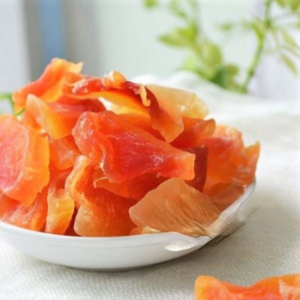Last updated on February 21st, 2025 at 11:16 am
Introduction
Dried mango is a delicious and nutritious snack that can be made easily at home. By drying mangoes yourself, you can control the ingredients, reduce added sugars, and enjoy a healthy alternative to store-bought snacks. This guide will take you through the process of making dried mango at home, including the best methods and tips to ensure you get the perfect results every time.
What You Need to Make Dried Mango at Home
Before you start, gather the necessary ingredients and tools. Here’s a quick rundown:
- Fresh Mangoes:
Choose ripe mangoes for the best results. You’ll need about 3-4 mangoes to make a batch of dried mango. Each mango should yield around 1-1.5 cups of dried mango slices. - Dehydrator or Oven:
A dehydrator is the most efficient method, but you can also use your oven if you don’t have one. For the oven, you’ll need a baking sheet and parchment paper. - Knife & Cutting Board:
For cutting the mangoes into even slices, use a sharp knife and a stable cutting board. - Optional (Lemon Juice or Salt):
Some people choose to dip mango slices in lemon juice or sprinkle salt before dehydrating to enhance flavor and preserve color.

Step-by-Step Guide to Making Dried Mango at Home
Step 1: Choose the Right Mangoes
Select ripe mangoes that are slightly soft to the touch. Look for mangoes that have a deep, rich color and a fragrant aroma. Avoid overripe or underripe mangoes as they may not dry properly.
Step 2: Peel and Slice the Mangoes
Peel the mangoes with a sharp knife or vegetable peeler. Once peeled, cut the mango into thin, even slices (about 1/4 inch thick). The thinner the slices, the faster they will dry. A mandoline slicer can help achieve uniform thickness.
Step 3: Optional Step: Prevent Browning
To preserve the bright color and prevent browning, you can soak the mango slices in a mixture of water and lemon juice (about 1 tablespoon of lemon juice per cup of water) for 5-10 minutes. This is optional but can help maintain the visual appeal of the dried mango.
Step 4: Dehydrate the Mangoes
If using a dehydrator:
- Arrange the mango slices in a single layer on the dehydrator trays.
- Set the temperature to 135°F (57°C) and dehydrate for 8-12 hours. Check the mango slices every 6 hours to ensure they are drying evenly.
If using an oven:
- Preheat the oven to its lowest setting, usually between 140°F (60°C) and 170°F (77°C).
- Place the mango slices on a baking sheet lined with parchment paper.
- Bake for 6-8 hours, flipping the slices every 2-3 hours to ensure even drying.
Step 5: Check for Doneness
Dried mango should be flexible and slightly chewy. When you squeeze a piece, it should not release moisture. If it feels sticky or wet, put it back in the dehydrator or oven for another hour.
Step 6: Cool and Store
Once the mango is dried to your liking, allow it to cool completely. Store the dried mango in an airtight container or vacuum-sealed bag. It can last up to 1 year if stored in a cool, dry place.
For more tips on how to store dried mango, visit How to Store Dried Mango Freshness.
Nutritional Benefits of Dried Mango
Dried mango is rich in essential vitamins and minerals, making it a healthy snack option. Here’s a breakdown of the nutritional profile per 1-ounce serving (about 1/4 cup):
| Nutrient | Amount per Serving |
|---|---|
| Calories | 130-150 kcal |
| Carbohydrates | 35-40 g |
| Fiber | 3 g |
| Vitamin C | 10% of Daily Value |
| Potassium | 5% of Daily Value |
| Iron | 2% of Daily Value |
Dried mango is also an excellent source of antioxidants, which help combat free radicals and reduce inflammation.
Frequently Asked Questions (FAQ)
- How long does it take to dry mango at home?
It can take anywhere from 6-12 hours depending on the method you use (dehydrator, oven, or sun drying). - Can you dry mango without a dehydrator?
Yes, you can use an oven or even air-dry the mango in the sun. Both methods will take longer but are still effective. - Is dried mango healthy?
Yes, dried mango is a nutrient-dense snack that’s high in vitamins and fiber. However, be mindful of portion sizes due to its high sugar content. - Can you add sugar to dried mango?
Adding sugar is optional. If you prefer a sweeter taste, you can sprinkle a little sugar or honey before drying, but this will increase the calorie content. - How can I use dried mango in recipes?
Dried mango can be used in smoothies, salads, baked goods, and even as a topping for oatmeal or yogurt.
For more ideas, check out Innovative Uses for Dried Mango.
Conclusion
Making dried mango at home is an easy and cost-effective way to enjoy this delicious snack. By following the steps outlined in this guide, you can create healthy, preservative-free dried mango to enjoy anytime. If you’re looking for high-quality dried mango products, Qualitex offers a variety of options that cater to both personal and business needs. Contact us to learn more.









